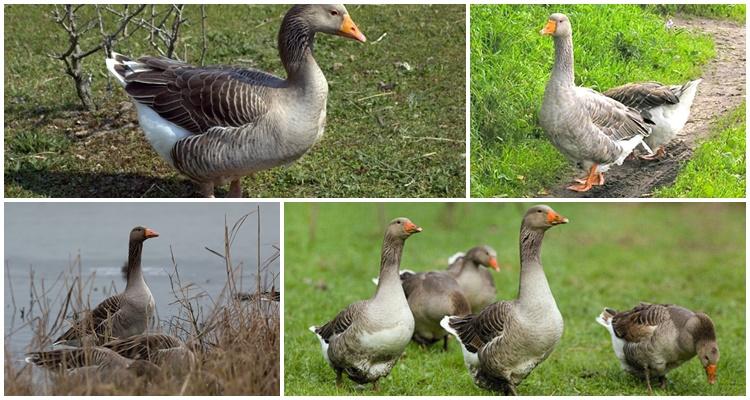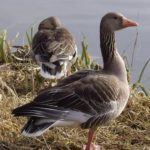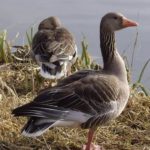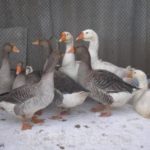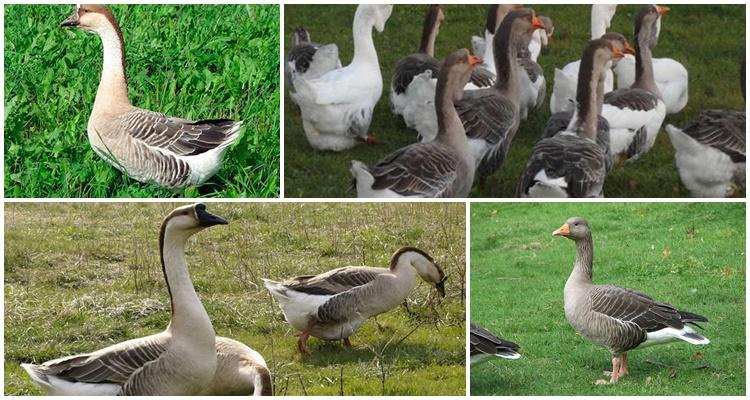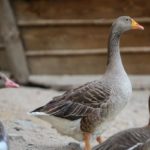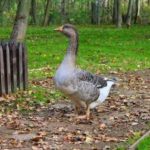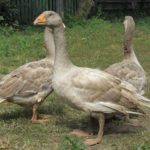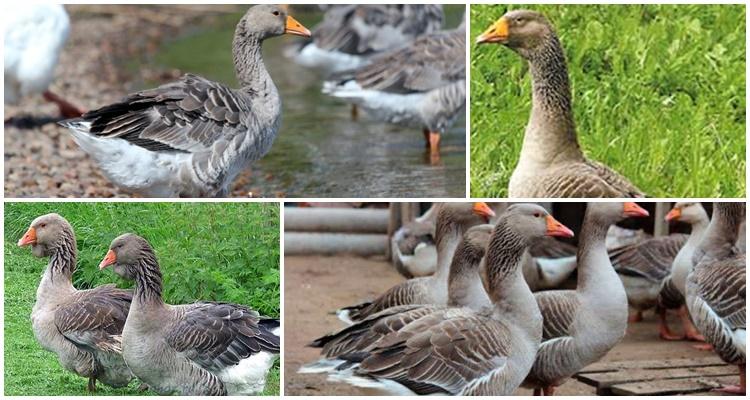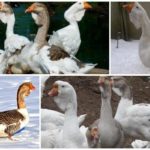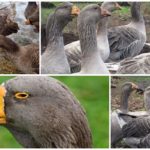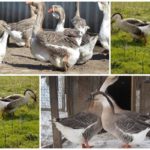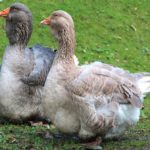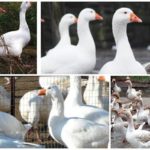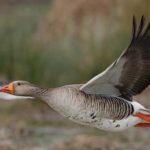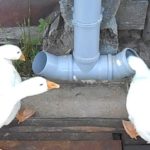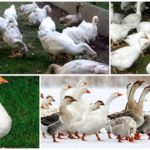In Siberia and the Ural regions, the Shadrinsky breed is popular, which appeared as a result of the domestication of wild geese, and received its current characteristics thanks to long-term selection work. The Shadrinsky goose cannot be called highly productive in terms of meat and eggs, but representatives of the breed have strong immunity, are adapted to northern climatic conditions, and are not capricious in their care.
A little history
At the end of the 17th century, in villages near the South Ural city of Shadrinsk, wild geese were tamed and the best individuals were selected for breeding.Selection work was carried out for several centuries, resulting in large birds with strong immunity and adaptation to the harsh climatic conditions of Siberia and the Urals. Selection continues: there is still a need to increase productivity and correct exterior defects.
There is an interesting legend about Shadrinsk geese. At the end of the 17th century in Shadrinsk, a city official stole funds collected by merchants for firefighters. When the summer heat arrived, a building on the outskirts caught fire, and windy weather contributed to the spread of the flames to neighboring wooden houses. Firefighters had a hard time fighting the fire; half the city burned out.
Angry townspeople threatened to write a complaint to the empress against the thief-official. But he hastened to justify himself to Catherine the Great and wrote her a letter of report. It indicated that half of the houses burned down by God’s will, from the surviving buildings “cockroaches are running into the fields,” which means that the remaining houses will also soon be engulfed in fire. And so that this does not come as a surprise to the townspeople, let the empress instruct them to “collect their belongings and deliberately set fire to the rest.”
Catherine was informed about a letter from a cunning and resourceful official. She answered: “What a Shadrinsk goose! It’s interesting to look at him.” The Empress said this about the official, but in the Ural province, where the order was sent, they took everything literally. And instead of the thief-official, they sent local geese to the capital.
The geese were prepared for the embassy dinner. The Empress and high-ranking guests enjoyed the treat. Shadrinsk geese began to be regularly supplied to the royal kitchen.
Characteristics and appearance of the breed
Shadrinsky geese are distinguished by a strong, moderately well-fed physique and well-developed muscles. The belly is tucked up, with slight fat deposits. The limbs are short, with a strong skeleton.The head is small, the beak is straight, the neck is short, the chest is moderately convex.
The description and productivity of the Shadrinsky breed are given in the table.
| Weight | Male – 6-7 kg, female – 5-6 kg |
| body length | male – 75-80 cm, female – 70-75 cm |
| wingspan | 160-165 cm |
| wing length | 43-48 cm |
| color | gray, white, mottled gray-white, orange beak, light pink paws with yellowish tint |
| annual egg production | 30 eggs weighing 160-170 g |
| survival of chicks in clutch | 90 % |
| goose liver weight | up to 400 g |
Meat productivity is low, but the meat is tender and dietary. Pates are prepared from the liver of the Shadrinsk goose. Goose fat, rich in beneficial substances, is used in the production of cosmetics and medicines. The down of Shadrinsk geese is harsh and not suitable for the production of pillows and blankets.
Pros and cons of Shadrinsk geese
Requirements for maintenance and care
The Shadrinsky breed is not capricious in care. The poultry house is made of planks, the roof is made of slate or roofing felt. The main thing is that there should not be a single crack; geese get sick from drafts. A mixture of sawdust, straw and sunflower husks is used as flooring. Contaminated litter is changed regularly.
The walking area should be spacious.Geese love to swim. If there is no natural body of water nearby, you should build a pool for the birds. In summer, a canopy is stretched over the walking area to protect the geese from the midday sun and rain.
Shadrinsky geese are immune to temperature, but the most comfortable temperature in the house is 12-18 °C. In winter, pets do not experience discomfort in the yard at temperatures up to minus 20 °C. When the temperature drops below, they should not be released from the house. The main thing is the absence of dampness. In severe winters, the walls are insulated and heaters are installed.
It is better to install wooden and plastic feeders and drinking bowls. In frosty winters, geese's paws can freeze to metal equipment. To prevent birds from crushing each other while eating, feeders are installed taking into account the number of individuals in the house. There should be 15 cm of feeder length per individual.
Diet and consumption standards
In the summer, geese graze and get their own food. The basis of summer food is pasture grasses. To increase meat productivity, the diet is supplemented with cereals and succulent plant food. The daily portion per individual is:
- 30 g corn;
- 90 g barley;
- 30 g peas;
- 40 g bran;
- 100 g boiled potatoes;
- 300-400 g beets;
- 4 g of chalk, shell rock, sand.
Supplementation to the herbal diet is done 2 times a day: morning and evening. An adult goose should receive 700 g of grass and 400-500 g of boiled vegetables per day. In the winter months, to strengthen the immunity of geese and ensure weight gain, the daily portion is increased, and mixed feed is added to the diet. There should always be fresh water in the drinking bowl. In winter, the water is heated to room temperature, preventing it from freezing.
Subtleties of reproduction
Males become sexually mature by 9 months of age, females reach sexual maturity at 9.5 months. Young Shadrin geese hatch about 30 eggs per season. The average weight of an egg from a young individual is 150 g; geese over one year of age lay eggs weighing up to 170 g. The number of eggs laid per season is affected by the length of daylight hours; for maximum results it should be 15 hours.
Shadrinsky geese have a highly developed maternal instinct. An incubator is not required, and if breeding is not planned, then the eggs should be removed from under the bird.
Shadrinsky goslings are strong and well-developed. After 2-3 days they can be released to pasture. By 5 months, with good feeding, the goslings reach 5 kg. Despite the cold resistance of the Shadrinsky breed, young animals should be kept indoors during the winter months, where the temperature remains stable at 18-20 °C.
Diseases and vaccinations
Shadrinsky geese have strong immunity. Diseases appear only due to improper maintenance and feeding, and poor hygiene in the poultry house. Chicks whose bodies are not yet strong enough are especially susceptible to infection.
To prevent infectious diseases, it is important to vaccinate goslings in a timely manner. The vaccine is given against the most common and dangerous infections:
- Viral enteritis. It is mandatory to administer a live vaccine to young animals at 22-28 days of age, to adults for the first time 45 days before egg laying, and the second time 2 weeks later.
- Pasteurellosis. Give a live or killed vaccine (at least 5 days after using the medicine).
- Paratyphoid. Conditionally infected goslings are vaccinated orally at 2-4 days of age, if vaccination was not carried out before laying. If produced, then at 8-10 days of age.Adult geese are vaccinated a month before entering the productive period, 2 times with an interval of 5 days.
To prevent aspergillosis, colibacillosis, neisseriosis, and other infectious and parasitic pathologies, it is necessary to comply with sanitary standards and rules for keeping geese, provide a high-quality and balanced diet, and give the birds vitamin supplements. Once a year, when the goslings appear, the poultry house should be thoroughly cleaned, the surfaces should be treated with caustic soda and covered with lime. Feeders and drinkers should be cleaned weekly.

